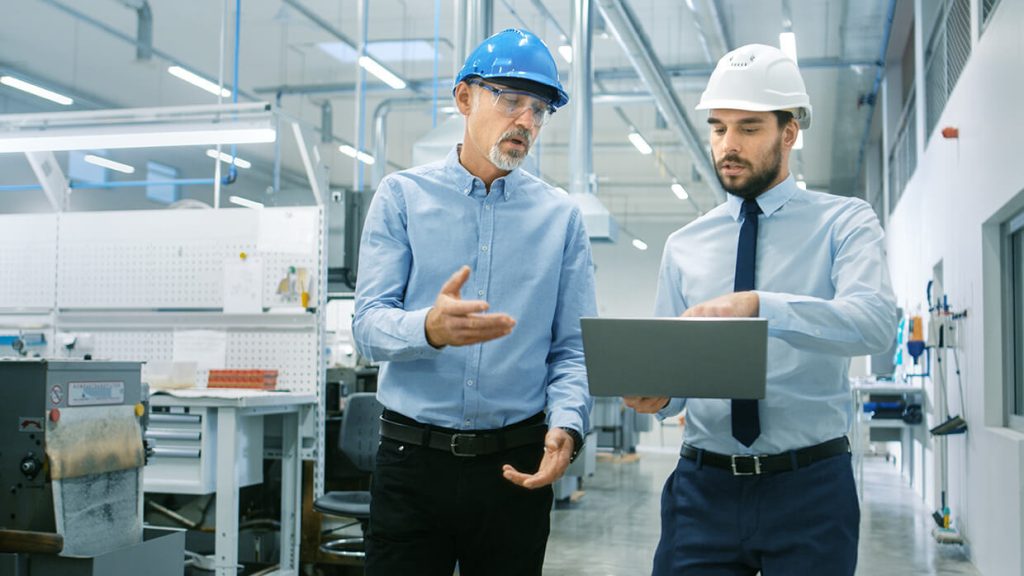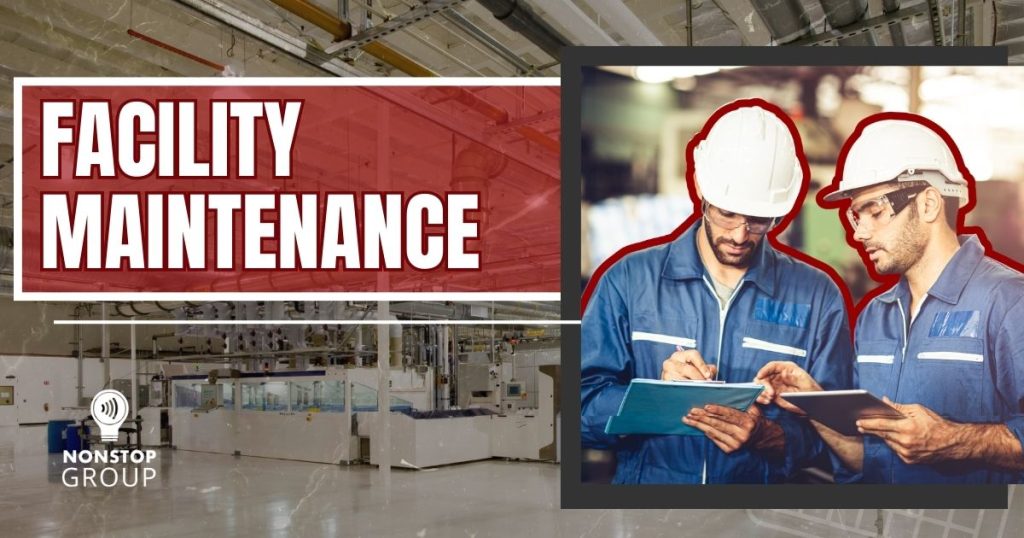6 Min Read

Your organization, buzzing with productivity, suddenly grinds to a halt due to a malfunctioning HVAC system. The discomfort is palpable, the frustration tangible, and the productivity plummeting. Such disruptions are not inconveniences; they are costly setbacks that can derail business efficiency.
That’s where facility maintenance comes in. Facility maintenance is pivotal for preserving an organization’s infrastructure, equipment, and machinery. Focusing on this maintenance technique, your organization can proactively maintain and optimize systems to prevent disruptions.
This blog post aims to explore facility maintenance, including its types, examples, and its crucial role in ensuring uninterrupted operations. Let’s dig in!
What is Meant by Facility Maintenance?

Facility maintenance is a process that ensures optimal condition of assets within a facility, aiming to minimize unscheduled downtime. It encompasses regular upkeep and repair of various systems, such as electrical, plumbing, and HVAC units.
The primary objectives of facility maintenance are to take preventive measures to forestall equipment failure and take corrective actions to address issues as they arise.
With facility maintenance, maintenance managers can ensure optimal functioning and longevity of critical facilities. As a result, the organization can successfully prevent costly breakdowns and disruptions to operations.
Examples and Application of Facility Maintenance
Facility maintenance involves regular upkeep and repair of buildings and equipment to ensure optimal functionality and safety.
In a commercial building, facility maintenance tasks may include HVAC system inspections, plumbing repairs, electrical system checks, and structural industrial maintenance. Regularly scheduled maintenance helps prevent breakdowns, prolongs the lifespan of equipment, and reduces overall operating costs. Additionally, this maintenance approach prioritizes safety measures to ensure workplace safety and compliance with international facility management associations.
PRO TIP
Modern operations require CMMS facility maintenance software for efficient management. This is where The NonStop Suite leaps! This dynamic solution enables your facility manager to schedule maintenance tasks, tag critical assets, equipment, and inventory with Smart NFC tags, and record, track, and communicate critical reports on a centralized database. Integrate The NonStop Suite into your organization’s facility maintenance strategy today to advance it to the next level.
Smarter Asset Tracking With NFC Tags
Learn more about how NonStop Suite's NFC Asset Tracking Solution can help your Enterprise streamline operations to new heights.
Get A Free Product Tour
What is the Role of Facilities Maintenance in Different Types of Buildings?

Facility maintenance is indispensable across diverse industries, building types, assets, and systems. Each establishment relies on maintenance services to remain functional, safe, and efficient. While equipment specifics may vary, the core facility maintenance tasks remain consistent.
Listed below are some types of buildings that commonly require facility maintenance:
- Industrial Facilities:Regular upkeep of machinery, safety standards, and production processes in factories and warehouses.
- Commercial Buildings: Building maintenance includes HVAC, plumbing, electrical systems, and general upkeep for offices, retail centers, and malls.
- Residential Buildings: Property maintenance for common areas, plumbing, HVAC, electrical systems, and landscaping in apartments and housing complexes.
- Educational Institutions: Ensuring safety, cleanliness, and compliance with regulations in schools, colleges, and universities.
- Healthcare Facilities: Maintenance for equipment, sanitation, HVAC, and emergency systems in hospitals and clinics.
- Government Buildings: Structural repairs, HVAC maintenance, and security system upkeep for government offices and municipal buildings.
- Transportation Facilities: Maintenance of runways, terminals, signage, and security systems in airports, train stations, and ports.
- Data Centers and Telecom Facilities: Preventing downtime with HVAC, electrical, and security system maintenance for server and networking infrastructure.
PRO TIP
Elevate your facility maintenance strategy with The NonStop Suite’s robust asset lifecycle management capabilities. By utilizing Smart NFC tags to tag critical assets and equipment, your facility maintenance department can ensure seamless tracking throughout their lifecycle. From installation to decommissioning, The NonStop Suite brings real-time visibility into asset performance and maintenance history, enabling proactive maintenance and cost-saving measures.
What are the Different Types of Facility Maintenance?

Maintenance is aimed at sustaining the functionality of facilities and equipment. It involves regular facility servicing to optimize performance and usage. These activities are crucial for any organization for any property, facility, or vehicle owner.
Corrective Maintenance
Commonly known as ‘break/fix,’ corrective maintenance addresses immediate issues like malfunctioning systems or equipment failure. While inevitable, its frequency can be reduced through proactive measures. Neglecting corrective maintenance leads to increased costs and continuous reactive maintenance.
Preventive Maintenance
Considered vital, preventive maintenance program involves proactive planning to extend equipment and facility lifespan. Regular upkeep reduces downtime and the need for corrective measures, ultimately saving costs. Shifting from task-oriented to purpose-driven maintenance fosters a culture of understanding and appreciation among staff and volunteers.
Predictive Maintenance
Utilizing real-time condition monitoring, predictive maintenance leverages IoT technology for early detection of potential failures. Sensors and data analysis enable timely intervention, preventing minor issues from escalating into major problems. Integration of IoT devices promises significant advantages for facility management in the future.
Deferred Maintenance
Deferred maintenance denotes neglecting necessary upkeep, leading to deteriorating facilities and increased costs. Geaslin’s rule highlights the exponential expense incurred when maintenance is postponed. Proper planning, preventive measures, and budget allocation are emphasized as cost-effective alternatives to deferring maintenance tasks.
What Does a Facility Maintenance Worker Do?

Facility maintenance workers are responsible for ensuring the functionality, safety, and cleanliness of buildings, equipment, and surrounding areas. They inspect the premises regularly to identify and address potential issues before they escalate.
By doing their job right, a facility management professional also plays a crucial role in maintaining a safe and functional environment for occupants. Their work helps preserve the property’s value and integrity over time.
PRO TIP
Effective communication is essential for successful facility maintenance operations. The NonStop Suite facilitates seamless communication and collaboration among facility maintenance teams, contractors, and stakeholders. Centralized databases allow instant access to critical reports, maintenance schedules, and task assignments, fostering teamwork, accountability, and timely resolution of issues.
Responsibilities and Duties
Typically, the facility maintenance professionals are responsible for performing these crucial maintenance activities in a facility:
- Repair and Maintenance: The facility maintenance job description includes conducting routine inspections and repairs on building systems. Tasks like electrical, plumbing, HVAC, and mechanical systems are maintained to ensure they operate efficiently.
- Safety Compliance: Facility maintenance jobs ensure compliance with safety regulations and protocols, such as fire safety measures, emergency procedures, and building codes.
- Preventive Maintenance: Performing scheduled preventive maintenance tasksto prevent breakdowns and prolong equipment lifespan.
- Cleaning and Upkeep: Performing cleaning tasks, such as janitorial duties, and maintaining the appearance of facilities and grounds.
- Emergency Response: Responding to emergency maintenance requests and addressing urgent issues to minimize disruptions.
Types of Facility Maintenance Workers
Maintenance workers like janitors, groundskeepers, and security personnel contribute to the overall upkeep of a facility. Each role plays a vital part in ensuring effective facility management. However, there are two main types of workers in facility maintenance: facility manager and maintenance technician.
Facility managers oversee overall maintenance operations. They manage cleaning schedules, fire safety systems, and maintenance of capital assets. With the help of computerized maintenance management system (CMMS) software like The NonStop Suite, facility managers schedule maintenance work, issue work orders, and keep track of all maintenance tasks in the organization.
Conversely, maintenance technicians are the hands-on workers who conduct routine maintenance and repairs. Their focal point is to carry out facility maintenance services to maintain building systems. Organizations use specialized training, such as HVAC certification, to enhance their technicians’ skill sets.
PRO TIP
Make informed decisions backed by comprehensive data analytics provided by The NonStop Suite. Utilize historical industrial maintenance data and performance metrics to identify trends, anticipate equipment failures, and optimize maintenance schedules. By leveraging the power of data-driven insights, your organization can extend the lifespan of your facility assets.
Conclusion: Streamline Facility Maintenance With Facility Management Software
Effective facility maintenance is achieved through the collaborative efforts of personnel and streamlined processes. To advance and facilitate this process, modern organizations rely on comprehensive facility maintenance management solutions like The NonStop Suite!
Presented by The NonStop Group, The NonStop Suite is innovative facility maintenance software designed for modern organizations. The combined power of its features, such as enhanced asset lifecycle management, Dynamic eForms, Smart NFC tags, and data-driven insights, can significantly improve your organization’s maintenance processes.
With The NonStop Suite’s ability to tag critical assets with Smart NFC tags, facility managers gain real-time visibility into asset performance and maintenance history. This accessibility to information allows them to take proactive measures to prevent downtime and reduce costs. Moreover, the suite facilitates seamless communication and collaboration among maintenance team, contractors, and stakeholders. Thus, facility managers can ensure everyone is on the same page and quickly address issues as they arise.
In essence, integrating The NonStop Suite into your organization’s facility maintenance strategy is more than just an upgrade—it’s a strategic investment in the future success and longevity of your operations.
Should your organization want to yield these results, consult The NonStop Group today and book a FREE personalized product tour. Take the leap and elevate your facility maintenance to the next level today with The NonStop Suite.

